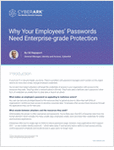 | Many enterprises turn to single sign-on (SSO) to reduce password usage. However, a wide range of apps don’t support SSO or use modern identity protocols. To fill the gap, enterprises often use password manager tools designed for personal use, which present various forms of risk:
What’s the solution? Read this whitepaper to learn about best practices for applying enterprise-grade protection to employee’s passwords. In the piece, Gil Rapaport, General Manager, Identity and Access, CyberArk, discusses four key areas:
Employees’ passwords should be protected with the same security-first approach that organizations apply to privileged users’ credentials. Meanwhile, the controls should enable a streamlined user experience. This whitepaper provides insights on how to achieve a balance between both areas.
Request Free! |
Why Your Employees’ Passwords Need Enterprise-grade Protection
 | Many enterprises turn to single sign-on (SSO) to reduce password usage. However, a wide range of apps don’t support SSO or use modern identity protocols. To fill the gap, enterprises often use password manager tools designed for personal use, which present various forms of risk:
What’s the solution? Read this whitepaper to learn about best practices for applying enterprise-grade protection to employee’s passwords. In the piece, Gil Rapaport, General Manager, Identity and Access, CyberArk, discusses four key areas:
Employees’ passwords should be protected with the same security-first approach that organizations apply to privileged users’ credentials. Meanwhile, the controls should enable a streamlined user experience. This whitepaper provides insights on how to achieve a balance between both areas.
Request Free! |
